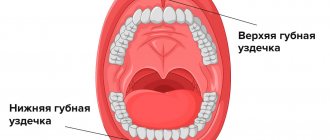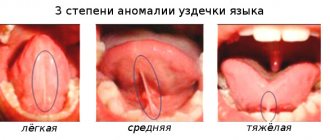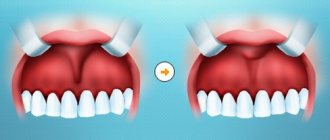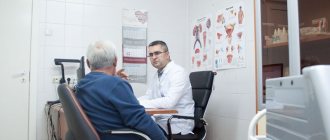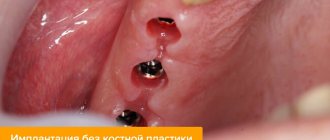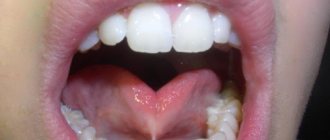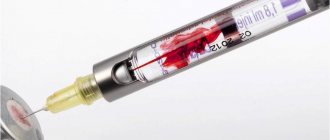May 31, 2020
Under the upper lip, right in the center of each person, there is a ligament that connects the lip to the alveolar part of the jaw and is called the frenulum. For some, this ligament is short and attached too low, which creates certain difficulties and health problems, which we will definitely talk about below. In this regard, doctors suggest that such patients undergo plastic surgery of the upper frenulum. And UltraSmile.ru journalists will tell you about the operation and its indications in detail.
There are many indications for frenuloplasty
Few people know that the upper frenulum is very important for the correct and full functionality of the dental system. Thanks also to her, we can move our lips, pronounce different sounds, and open our mouths. It also plays an important role in the formation of a beautiful smile aesthetics. If it is shortened or positioned incorrectly, then in some cases this creates conditions for the development of various anomalies and leads to serious problems and consequences, which, in fact, are indications for trimming the frenulum of the upper lip in adults and children.
At what age is it best to have surgery?
Trimming the frenulum of the upper lip is a relatively easy operation, but the optimal age for it, according to most doctors, is 5–7 years, when the permanent incisors begin to emerge. If you carry out the procedure during this period, you can avoid the formation of a diastema and further manipulations to correct the bite by the orthodontist. But according to indications, it is not too late to perform plastic surgery in adolescence, and even in adults.
“I took my child to this operation. My son was 8 years old at the time. He already understood everything that was said to him, and at the same time he was very afraid. Before the operation, we sat and calmed down in the doctor’s office for about 15 minutes. I want to say that the child’s psychological attitude is very important here. About the operation itself: it didn’t hurt, my son didn’t cry. But after the anesthesia began to wear off, he complained that his gums hurt, but this problem was solved with Nurofen syrup. Already on days 4–5, the trace of the wound was almost invisible, although it was done with a scalpel. But in children everything heals quickly.”
Lada, review from the dental portal gidpozubam.ru
The operation is best performed at the age of 5-7 years
What is dangerous about the pathology of the frenulum attachment?
Indications for frenuloplasty arise not because of doctors’ desire to correct an anatomical feature, but for compelling reasons that affect the health and beauty of the smile. A similar defect results in:
- to the formation of a diastema - an excess gap (gap) between the front incisors, which, moreover, tends to expand. A short frenulum is fixed too close to the edge of the alveolar process and pushes the teeth in different directions;
- the appearance of a gum pocket - a depression behind the gum due to its injury by the frenulum, where food debris begins to accumulate, tartar forms, and the exposed necks of the teeth suffer from increased sensitivity. Ultimately, this process can lead to periodontitis, loosening and loss of teeth;
- speech problems - with a short frenulum it is difficult to pronounce many consonants and some vowels (“o”, “u”);
- bite pathologies - due to improper closure, tooth enamel is erased, teeth grow in the wrong direction, oral hygiene, the quality of chewing food and the functioning of the entire gastrointestinal tract deteriorate, and at the same time, a short frenulum prevents the correct installation of the braces system;
- difficulties when performing prosthetics - a short frenulum does not allow the prosthesis to be firmly held in the mouth, and it may fall out while eating or talking;
- injury during individual oral hygiene and its deterioration in general.
Types and technologies of upper frenuloplasty
Before the procedure, it is important to carry out a complete sanitation of the oral cavity, treat diseased teeth and stop acute inflammatory processes, remove bacterial plaque - all these are sources of infection, which can subsequently provoke postoperative complications. You should also eat before surgery, as hunger can impair blood clotting.
There are several techniques for performing the procedure. The doctor decides which one to use depending on the patient’s age, the location and attachment of the frenulum. Let's list all the technologies that exist today:
- frenotomy, or frenulotomy: involves transverse dissection of the frenulum if it is very narrow and thin. This is the so-called minor operation, which is considered the least traumatic. The purpose of the manipulation is to relieve the tension of the ligament. The procedure can be performed on newborns, as well as older children,
- frenectotomy: this is a more complex operation, during which the frenulum of the upper lip is trimmed and part of the tissue located in the space between the central incisors is removed. The procedure is performed if the frenulum is thick, as is often the case in adolescent and adult patients,
- frenuloplasty: the doctor releases the ligament and moves it to the area where it should be.
The operation is performed under local anesthesia.
Each of the listed operations is performed on an outpatient basis, under local anesthesia. Traditionally - using a scalpel. Afterwards, the doctor applies self-absorbing sutures and sends the patient home. Everything lasts about 10–15 minutes. Next, the patient receives clear recommendations on how to behave during the rehabilitation period. 1 and 3 days after the operation, you need to visit the doctor again for follow-up examinations.
Today, plastic surgery of the upper frenulum can be performed using a laser, which allows the procedure to be carried out quickly, without pain and blood, and to disinfect the operated tissues. This also reduces the likelihood of developing postoperative complications (swelling, pain, inflammation, scars). A big advantage is that when using laser equipment there is no need to apply stitches.
Laser frenulum trimming is the least traumatic
The rehabilitation period takes about 10–14 days. During this time, the patient is not recommended to eat food that can irritate the operated tissues (cold, spicy, hot, hard). It is also necessary to rinse your mouth with an antiseptic and apply wound-healing ointments (for example, Solcoseryl).
Notice
: Undefined variable: post_id in
/home/c/ch75405/public_html/wp-content/themes/UltraSmile/single-item.php
on line
45 Notice
: Undefined variable: full in
/home/c/ch75405/public_html/wp-content /themes/UltraSmile/single-item.php
on line
46
Rate this article:
( 3 ratings, average: 5.00 out of 5)
prevention
- Alimirzoev F.A. Dental anomalies in childhood and their diagnosis // Achievements of university science. – 2014.
Is special training required?
The procedure does not require special preparation. Immediately before surgery, it is necessary to perform thorough oral hygiene. You also need to feed the child - hunger negatively affects blood clotting. In addition, it will be difficult to eat for several hours after the operation.
Since plastic surgery of the upper lip frenulum is performed mainly on young children, first of all, psychological preparation is necessary. Parents should reassure the child, assure him that the procedure is painless, this will help significantly speed up and simplify the doctor’s work.
Comments
Which doctor can give a referral for this operation?
Marina (06/14/2020 at 07:28 pm) Reply to comment
- You can get a referral after an examination by a dentist or periodontist, orthodontist, speech therapist, or neonatologist (for newborns). The operation itself is performed by a dental surgeon.
Editorial staff of the portal UltraSmile.ru (06/17/2020 at 09:07) Reply to comment
Write your comment Cancel reply
Post-operative care
The rehabilitation period takes one to two weeks. To avoid complications, you must follow your doctor's recommendations:
- monitor the hygiene of the oral mucosa and perform procedures prescribed by a specialist;
- exclude hot, sour and solid foods;
- undergo a follow-up examination with the surgeon who performed the operation;
- do gymnastics to strengthen the chewing muscles.
The above rules will help you return to your normal lifestyle in a short time and prevent deterioration in your health after lip frenuloplasty.
Torn frenulum
It often happens when a child, injuring the upper lip, causes damage to the frenulum - it ruptures. In such a situation, you should immediately seek help from a doctor. Not only to treat the wound, but also to avoid complications when the frenulum heals on its own.
After all, without proper surgical treatment, there is no guarantee that the frenulum will heal correctly and not asymmetrically. In addition, a rough scar will appear, which will limit the mobility of the lip. And this, in turn, will lead to speech impediment. After such an injury, the child will need to be taught exercises that will promote the mobility of the organ responsible for articulation and allow the frenulum to be slightly lengthened.
How does the procedure work?
The form and duration of the operation to correct the lip frenulum directly depends on its type. Surgery using a scalpel or laser lasts about 10 minutes. The child must sit still in a chair until the operation is completed. During the procedure, the dental surgeon makes the necessary incision or resection. Then he puts stitches.
Plastic surgery using a laser does not require additional antibacterial treatment - the frenulum is sealed, which eliminates the further development of infection. This procedure lasts less than 10 minutes and is completely bloodless.
Before plastic surgery, the mucosal area is numbed with a special anesthetic gel.
Minor discomfort may occur for several hours after surgery. In the next few days, it is necessary to maintain careful hygiene and avoid eating hard and hot foods so as not to irritate the frenulum. The rehabilitation period is aimed at ensuring that the frenulum heals faster.
Dental therapist's opinion
Frenuloplasty is a simple operation that will help the child avoid many unpleasant consequences for health and speech. Many parents do not take this condition seriously and delay visiting a doctor. However, you need to understand that a short frenulum when changing the bite can disrupt the normal growth and relationship of the teeth. Today we use gentle techniques and high-quality anesthesia, so the entire process for young patients is painless and in a comfortable atmosphere.
Contraindications for surgery
Like any surgical intervention, frenuloplasty has contraindications:
- Bleeding disorder
- Congenital pathologies of the oral mucosa
- Multiple caries (operation is carried out after treatment)
- Osteomyelitis
- Malignant neoplasms
- Mental disorders
- Autoimmune diseases
- Immunodeficiency
- Tendency to form keloid scars
- Severe diabetes mellitus
- Any infectious and somatic diseases during exacerbation
What pathologies require solutions?
Normally, the frenulum of the tongue starts from the tip of the organ and ends in the area of the lower incisors. It is located exactly in the center (bottom). These are the perfect sizes. The main pathology that occurs is a shortened frenulum, which leads to limited mobility of the tongue.
As for the frenulum of the lip (pathologies are mainly found on the upper one), then normally it should be located between the front incisors and at the base of the lip. Such a film can be very short, which will lead to tension on the mucous membrane, or excessively large and will overlap the front teeth.
Due to such pathologies, a complex of problems arises, without eliminating which you risk creating serious troubles in the child’s life. And they will have to be resolved over more than one year.
Possible consequences
Often minor damage does not cause any unpleasant consequences. The same thing applies if the mucous membrane has been restored to its normal state. If medical correction has not been carried out, the tissues have grown together incorrectly, this can cause problems as a person grows and in his later adult life:
- problems with pronouncing certain sounds, especially if the injury occurred before the baby first spoke;
- susceptibility to infections of the oral cavity, if the tissues have grown together crookedly, there is no normal oral hygiene;
- Gastrointestinal problems can occur due to the fact that children do not chew food well after gum injuries.
Kids are active and curious, they require the attention and responsible attitude of adults. Childhood injuries happen everywhere; the frenulum can tear even from excessive efforts when brushing teeth or a minor bruise; only the doctor decides whether to stitch it up or not. Many speech therapists do not see a connection between such damage and poor diction. Parents should not be afraid of a protruding lip after surgery. A child can even tear the mucous membrane several times; the main thing is not to panic and maintain a reasonable approach to the treatment and prevention of injury.
Why frenulum abnormalities require seeing a doctor
Abnormalities of the labial frenulum
Such a frenulum (either short or long) leads to the fact that the front teeth move apart and a gap forms between them - a diastema. In addition, over time, gum recession occurs and tooth roots become exposed. This is dangerous because teeth become more sensitive and the risk of caries increases.
Anomalies of the frenulum of the tongue
- feeding difficulties: immediately after birth, the baby experiences difficulties, he has to make Herculean efforts to suck breast milk or a bottle of formula. Discomfort makes the baby refuse to eat, the baby becomes very capricious, and loses weight. This is due to the fact that the sucking reflex is impaired, since the tongue is limited in movement,
- Digestive problems: difficulty eating and swallowing leads to diseases of the gastrointestinal tract,
- developmental delay: such a child takes longer to gain weight than healthy ones and grows worse. Not receiving the vitamins and substances the body needs, it begins to lag behind its peers,
- articulation disorder: the voice becomes hissing or whistling, a lisp appears. The change in diction is explained by the fact that the child cannot pronounce certain sounds normally - again due to limited tongue movement,
- the development and proper functioning of the entire maxillofacial apparatus is disrupted.
Most often, a violation of the structure of the frenulum is a congenital pathology; there is also a high probability of the pathology being transmitted by inheritance - studies note1 that parents who suffered from this disease in childhood had beloved children who were also susceptible to a similar anomaly. But in some cases, the reason lies in the occurrence of problems during pregnancy: these could be frequent stressful situations, a lack of vitamins, or untreated infections in the baby’s mother.
